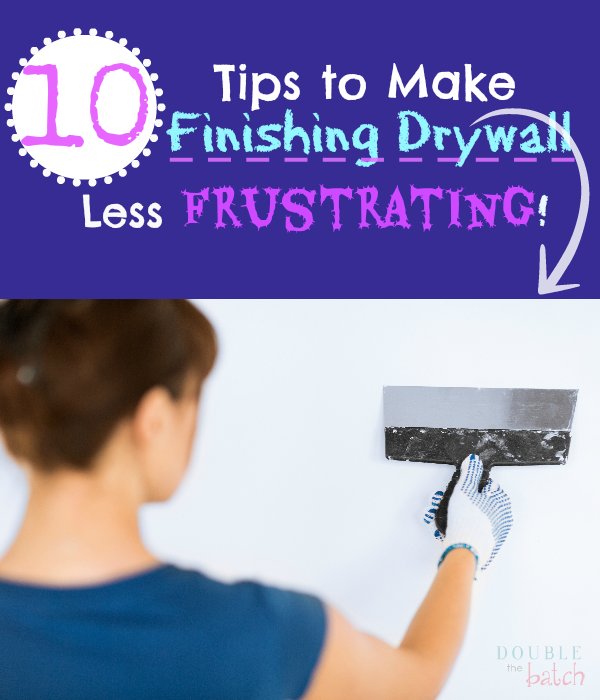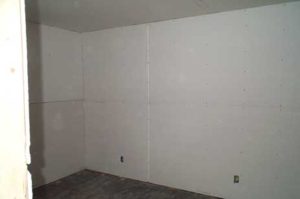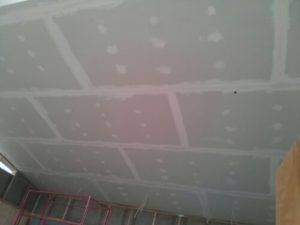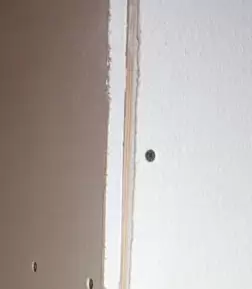I am married to a very handy (and handsome) guy named Dan. Dan gave me a tool belt on our 3rd date and I helped him hang some drywall. He couldn’t help himself. He’s a hopeless romantic. I had no idea how much I would be putting that tool belt to use in the future, or I may not have accepted it. (-: Frankly, I didn’t even know what walls are made of before I met Dan. But, we have tackled many a remodel project together in our married life, and I have learned all kinds of skills that I never imagined I would. I think he wanted to train me in his skills so that I could take care of projects around the house that he just doesn’t have time to get to. And guess what? I can and I do, and it is actually very satisfying!
So, ladies, my message is don’t be afraid to get your hands dirty! With some self-determination and a little help from Google and YouTube, you can fix most the of the things around your house that are driving you crazy. You may very well save your marriage, and most definitely lots of money, by not paying a handyman to do the things your husband is too busy to get to, bless his well-intentioned heart.
I will do a series of posts with helpful hints on how to do some of the most common repairs and remodel projects around your house. And we will start today with drywall, since this is my area of expertise.
Finishing Drywall is a job that most people hire out. And for good reason. It does take practice to successfully finish drywall without needing to do a massive amount of sanding. And let’s be honest. Sanding drywall is a miserable, messy, frustrating experience. I try to avoid it as much as possible. But, maybe you, like many, can’t afford to pay someone to finish your drywall and you just have to get it done yourself. Here are some tips that I hope will make your experience less frustrating.
1- Drywall is much easier to finish if it is hung well. Do not be scrappy with your drywall. You may think you are saving money by using up every little piece of drywall, but in the end you will create several more hours of work finishing all the extra seams and butt joints you have created. Use as many large pieces as you can. Do not railroad your drywall! This means you stagger your butt joints (butt joint= where the two shorter, untapered edges of drywall meet) along your seams (seam or factory edge= where the longer tapered edges of drywall meet.) You should never put a butt joint from top to bottom. Do not hang your drywall vertically, it is harder to climb up and down on a step ladder to finish the long seams rather than walking back and forth to finish one in the middle of your wall. Make your seams and butt joints are as tight as possible. Measure and cut carefully.
Railroaded butt joint: WRONG! Staggered butt joints: RIGHT!
(source: users.westco.net) (source: mchouseonmcleod.wordpress.com)
2- I prefer to use self-adhesive mesh tape, not paper tape. Paper tape bubbles and is harder to apply. Grid tape is self-adhesive and you just stick it on and mud right over the top of it. I find for me, it fits into angles and is easy to use. Some feel that paper tape is easier in angles, so go with whatever your preference may be. This tape is also great to use for patching holes in your walls.
3- Spend the money to get a good metal pan. DO NOT USE A PLASTIC ONE! It may be cheaper, but it is much harder to clean out, which means you will end up with little dried up chunks of mud in your fresh mud that will leave lines in all your new coats and it will drive you MAD. Good metal knives are also a must. NO PLASTIC! No plastic is invited to your mudding party. Got it? None. Great. Let’s move on.
4- I have found of all the corner bead out there, metal corner bead that you nail on is the hardest to work with. It bends if you don’t nail it just right and it is really hard to fix warped areas with mud. The white plastic kind that you put on with a spray adhesive is really the only option if you are doing arches, so use it for those, but for normal corners, sometimes the adhesive doesn’t stick well and it is difficult to deal with as well. I use tape-on cornerbead. It is metal on the inside and paper on the edges. With this kind, you put mud on the drywall edge of your outside corners before you stick the corner bead on. You do have to wipe the mud carefully to ensure it doesn’t bubble or have any areas where there is not any mud under the paper but, over all, it is easier to work with.
5- Speaking of corners… a common mistake people make when hanging their Sheetrock is overlapping the Sheetrock on the corners. This is a NO NO and will make finishing your corners miserable. You want to make sure the edge of your sheet rock matches the edge of your stud on both sides of the corner leaving an empty triangle of space right on your corner. Doing this allows your corner bead to sit flush on your wall and it keeps it from rocking back and forth and looking uneven. If you have already made this mistake hanging, use a key hole saw or Sheetrock knife and cut a the corner flat before you put on your corner bead.
(source: www.diychatroom.com)
6- And now for the hardest part. Spreading the mud. You want to use the edge of your pan to make a thick bead of mud on the edge of your knife.
For your first coat, use a 6 or 8-inch knife. Then increase to a 10-inch and 12-inch for your second and third coats. The key is to not be heavy-handed with the mud. Put your knife at an angle with your wall in the corner you choose to start with and then gradually decrease the angle as you spread along your seam and the mud fills in the space. Use your index finger to steady the knife and apply pressure on the back of the knife. I usually repeat this until I have half of the seam coated. Now go over the mud you spread again, this time using your thumb on the top end of the back of the knife to apply pressure to taper the top edge of your mud. Then go over it again and use your middle finger to apply pressure on the bottom end of the back of the knife to taper the bottom edge. Tapering is essential if you don’t want to spend hours and hours sanding. Taper every coat you do so you can hardly tell where the edge of your mud and the drywall meet. (See video below)
7- Do your seams first and then “feather” in your butt joints. Butt joints don’t give you the luxury of tapered edges like the seam joint does, so they have to be coated wider in order to hide the bump where they meet. The first coat you can just do one coat down the middle. But, for your second and third coats, you want to coat both sides of the seam and overlap your mud in the middle. Always increase your knife size with each coat so you can smooth out the middle without leaving lines. As you do your second and third coats, move your knife down and then curve it into the seam on the one side and then the other (almost like drawing a J and a backwards J with your knife) so that it flow into the outside edge of your seam instead of cutting straight down into it. Then, taper the edges just like you did with your seam and do a final soft, smoothing, swipe down the middle. (See video below)
8- Coating your inside corners can be tricky. Use a knife like this:
Use a six-inch knife to put a layer of mud on each side of the corner and then use the corner knife to smooth it out. Then taper your edges with the six-inch knife. This will be the most difficult part of your project to do without a lot of practice. Just do your best and let your sanding sponge do the rest. (See video below)
9- Applying your corner bead to your outside corners can be tricky as well. Measure and cut your corner bead to begin. Place the corner bead tight to the ceiling and leave the small gap at the bottom where it will be covered with trim later. (It doesn’t have to be cut perfectly.) This is the best tool for cutting it:
Then put an even bead of mud on either side of the corner with your six-inch knife. Put the corner bead on and make sure it is straight top to bottom. I usually start from the middle and use my thumb and index finger to push the tape into the mud up to the top and then down to the bottom. Then, use a six-inch knife to put pressure on the tape part and push out the excess mud. IMPORTANT: Do not put your knife on the actual metal edge of the corner bead when taping it on. If you do, it will sometimes cause the corner bead to “rock” to one side or the other causing it to not be square and making it look like garbage when you are done. Get close, like 1/4 inch kinda close to the edge of the bead, but that’s close enough for setting the bead and getting the mud out from under it.
Once the mud has been pressed out, the bead wont move so easily, and NOW you can coat over the bead. Use an 8-inch knife for this coat. TIP: When coating corner bead, spread that mud with a slight pull in the direction of the metal bead. Doing this ever so slightly will keep mud from building up on the opposite corner. (you know…the one you just coated perfectly?) Coat a good solid bed of mud over the corner bead and drywall, and feather the edge. go back over it a time or two to smooth it out, or fill in voids. Rounded corners have to dry and be sanded between coats. Straight corners you can just scrape any chunks off the actual corner with your knife and then coat again once the previous coat has dried.
10- Use a sanding sponge like this to do your sanding.
The angled edge will help you in your corners. The most critical part of sanding is to make sure your mud-coated edges are completely smooth and then lightly sand the middle so you don’t sand all the way down to the tape. Sand off lines that are on top of the mud. Any line or hole down in the mud, circle with a pencil as you go along and then go back and touch them up with mud when you are done sanding. Touch-ups need to be sanded as well once they dry. DO NOT SAND UNTIL THE MUD IS COMPLETELY DRY! Be patient or you will create more work for yourself.
Last of all…all those pesky screws! Wipe a small coat of mud over a screw in one direction, and then wipe off the mud tight going the opposite direction. (This keeps little air bubbles from forming over the screwhead as it pushes the mud both directions, filling the screw hole.)
I have included links to a couple of YouTube videos that I think are valuable tutorials.
The first one shows how to repair damaged drywall. He uses a fast set mud which I use a lot to speed up the coating process. You have to mix it yourself and work faster with it, but it is great for repairs. His technique is a little different than mine, but not much. I would also use a little bigger knife for my second coat. But, he gives a good demo of tapering mud which is so important if you don’t want to spend hours sanding.
Check it out here: https://youtu.be/_A5rxkl0OHo
This link will show you the difference between coating a butt joint and a seam or factory joint. He uses paper tape, but it is the same with mesh tape. Pay close attention to how he loads the bead of mud on the end of the knife. This is just the way I do it.
Check it out here: https://youtu.be/1Th3Ed7NGY8
This link will show you how to use the corner trowel. She uses paper tape, but I do it the same way with mesh tape. The only thing she leaves out is tapering the edges so you don’t have to sand them as much. I would definitely not skip that step!
Check it out here: https://youtu.be/cr-vImEx3UM
Good luck and happy mudding to you!












